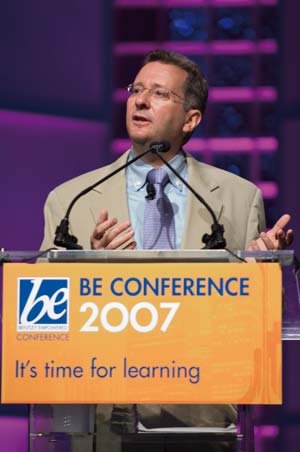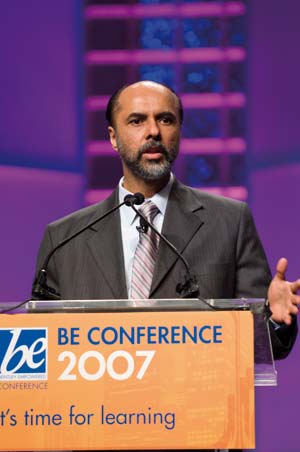This yearÝs ÙBentley EmpoweredÝ (BE) Conference was held in downtown Los Angeles.
Martyn Day attended to both judge the companyÝs Excellence awards and get the latest Bentley strategy.
BentleyÝs User conferences are always big affairs and were historically held in the companyÝs home town of Philadelphia. But for a number of years now the event has toured the United States, landing at Baltimore, Atlantic City, Orlando and Charlotte. This year it was its first west coast destination, Los Angeles, in the Staples convention centre. I canÝt help but think that being a Bentley customer is a great way to see the US and now also Europe. Last year saw BE come to Prague for a European leg and this year London is the host city. However, thereÝs little time for sightseeing as the company always lays on almost a weekÝs worth of keynotes, training and demonstrations – everything you wanted to know about MicroStation and more!
Bentley is a company that keeps a fairly low profile, so for those of you that donÝt know much about the company, it is one of the largest privately owned software companies in the US, with revenues of almost $400 million, and the Bentley brothers, of which there are more than a few all take active roles. Greg Bentley is CEO, Keith Bentley is CTO and Ray and Barry Bentley are Executive VPs – the company also has 2,495 other employees.
Over the years Bentley has developed into the CAD company for Infrastructure. Nearly all the US State Department of Transports (DOTs) use Bentley products, the company dominates the Civils market, is a key player in Process and Plant, supplies the US Army Corps of Engineers, is big in railways and water treatment and mapping and Geo. Then, of course, especially in the UK, thereÝs AEC design especially in mid-sized firms and at signature architect level. By attending BE one really gets a great insight into the breadth of markets that Bentley competes in, and by taking part in the judging of the Bentley Excellence awards, I had additional exposure to the size and scale of projects that BentleyÝs customers undertake.

Greg Bentley CEO
And so having given you a little background, what did Bentley have to say to its customers? Greg BentleyÝs Keynote kicked off with an examination of the increased productivity of its users, tying this into BentleyÝs relatively new On Demand learning and Institute services, allowing users to train where and when they want.
Greg Bentley announced ProjectWise V8 Passport, offering portable and global licenses allowing access to any ProjectWise client, desktop or web application. The aim is to reduce the costs of collaborating across multiple projects, when it has been based on a per-project model. ProjectWise V8 Navigator is a new review and analysis package for multiple file formats, in a ProjectWise Startpoint or ProjectWise Integration Server.
With the focus of the event clearly being BentleyÝs customers, Greg Bentley then literally went around the world, starting off in Los Angeles, highlighting a number of customers (many household names) and their projects, explaining how they managed to innovate and achieve better economic productivity. In his final round up, the CEO showed BentleyÝs acquisition momentum, as it buys up many of the specialist analysis firms. As Bentley predominantly operates a subscription model, licenses are the lifeblood of the company revenues, and again for the fifth consecutive year, subscriptions were up. A new and innovative company division, Bentley Direct, headed up by former Chief Marketing officer, Tony Flynn, has been established to sell to new and existing customers. Bentley has few dealers and tends to sell direct, this new division is a more volume approach using the latest web and electronic technologies.
{mospagebreak}
Bhupinder Singh, Senior VP, Bentley Software
Next on stage was Bhupinder Singh, who has taken over the strategy and direction of BentleyÝs software development. In his first statement, Singh recommitted to the Bentley vision of, one platform, a comprehensive portfolio and ongoing technology innovation. Bentley is the MicroStation company and nearly everything is based on that underlying architecture, or developed to extend or enhance these MicroStation-based applications. By having one platform Singh elaborated, it means that all development is standards-based, extensible desktop and server, through multi-connected workflows.

Coming from the ProjectWise and Collaboration development side of the business, it was unsurprising to hear Singh spend some time here. ProjectWise Navigator, for viewing and mark-up is actually designed on MicoStation V8 and is proof of the one platform promise.
The Bentley portfolio of products is very, very big ± Building, Plant, Civil and Geospatial with MicroStation and ProjectWise are the substrate for all. Again using customers as examples, Singh toured the verticals showing how Bentley was innovating within each market, addressing and refining workflows and providing efficiencies through application integration and interoperability.
However, Singh did reiterate a promise that Bentley has tried to keep but obviously had some problems keeping. With so many products, making sure everything works together at the same time is a massive task. When MicroStation V8 was introduced, Bentley attempted to synchronise the releases of all its products. Obviously over time this has been difficult to maintain. The next release of MicroStation, codenamed Athens, will be another chance to pull all the Bentley development teams together. For now Bentley has introduced the ÙCompatibility zoneÝ, where at a glance you can tell what versions of each application are certified to work together.
The Athens project was the big announcement of the event. This next release of MicroStation, slated for sometime next year, will feature conceptual design tools, dynamic 3D views, distributed project capability and built-in geo-co-ordination.
Conceptual tools in CAD is the new big thing. CAD has always been this regimented computerised way of accurately drawing things. Conceptual modelling requires less precise, freehand sketching and the capability to turn these sketches into something more useful for proper detailing. ItÝs a tough computer science task but there have been some great innovations in this area. AutodeskÝs AliasStudio and GoogleÝs SketchUp are the kinds of products IÝd advise you to look at to get a view as to what is possible today. BentleyÝs vision is to provide a tool that provides a rapid transition from idea to form, iterate quickly through design alternatives and provide a tool that answers more questions earlier on in the design process. In the package this will mean that MicroStation will be able to do interactive push/pull modelling, manipulate integrated surface, solids and mesh modelling and there will be a Rhino import capability. The companyÝs exciting Generative Components technology will also benefit from these additions. So expect some very cool stuff for architects in the Athens release.
Dynamic views offer a new way to author and visualise designs. It will be interactive and work off live content, so there will be no need to extract drawings, with section and elevation markers. These features will feed through into all the vertical applications, e.g. in Civil it will be possible to work in a cross section and exaggerated profile views.
For distributed teams, Bentley is planning Athens to improve on performance of uploading and downloading over high latency bandwidth connections. Together with improvement of sharing managed content.
With SinghÝs presentation there were a number of platform keynotes. Here each vertical got to explain the highlights of Athens for their customers. The one presentation and technology that stood out was Bentley VP Styli Camateros. Athens will have Geo-co-ordination built-in. Camateros pointed out that there are many co-ordinate systems for geo data and it would in fact be easier if the world was actually flat but itÝs not, itÝs an Ellipsoid. As a result we have to put up with multiple representations, which unfold the Earth and mimics ÙflatnessÝ. These projections are all based on co-ordinate transforms and donÝt easily map to traditional Cartesian geometry systems. Athens will now take that problem away by automatically coalescing content in different formats, from different sources both on the desktop and on the server.
The user simply assigns the spatial location and MicroStation will automatically re-project for attach display and search. As with all geo presentations, somehow we ended up in Google Earth.
Keith Bentley, CTO
With much of the future tech now out of the bag, Keith Bentley mainly reinforced the companyÝs vision of development, explaining the platform layers and the benefits of a single platform, albeit an evolving one. Bentley goes to great lengths to try and lessen software impact, having only changed the DGN format twice in the companyÝs history.
When it comes to hardware, Keith Bentley was offering the following advice; MooreÝs Law is running out of steam, so parallelism is the new source of power ± multiple processors on a single chip. Multi-core and the rise of something called a GPU (Graphics Processor Units). In the not too distant future, computers will have many processors which will be dynamically allocated to running applications. However with the move to 64-bit everything is going to take more memory, including caching and working with Tera-drives.
{mospagebreak}
Keith Bentley explained that today MicroStation XM will use all the available memory on a 64-bit computer but not the extra 32-bits of processing power. The 64-bit version is coming (Athens), so donÝt buy anymore 32-bit computers and make sure you buy multi core 64-bit processors. In the graphics world Bentley is seeing big developments with Shader Model 3 and Direct3D 10.
Buddy Cleveland, Senior VP, Applied Research
Another new innovation is Bentley Applied Research, under Bentley long-timer Buddy Cleveland. The purpose of the division is to expand the companyÝs R&D activities to partner with customers and research institutions to select, fund and develop new product-focussed technologies. While Bentley has always spent a large amount on R&D, most of this effort has been internal. This will now expand to include input from other sources. Areas highlighted for research include Digital Fabrication, Law Curves, Pattern Editing, Remote Video, RFIDs and Digital Pen and Paper.
Malcolm Walter, COO
Walter wrapped up the main plenary session with a keynote on ÙReturn on InnovationÝ. According to the National Institute of Standards and Technology (USA), the lack of interoperability among CAD engineering and design systems costs $15.8 billion. While the manufacturing market has seen gains in productivity, the productivity of architects over the same timeframe has become even more inefficient. Approximately 25% of an engineerÝs time is spent looking for data and an additional 20% is wasted in data conversion. Added to this itÝs estimated that by 2010, the USA will be 700,000 engineers and technicians short. So, we waste lots of time and money, challenges are escalating and there is a shortage of resources thatÝs only going to get worse.
Building
BIM for Architecture: Rogers Stirk Harbour & Partners Ltd — The Leadenhall Building
BIM for Building Engineering: M/E Engineering, P.C. — BioMed Engineering and Optics Laboratory Building
BIM for Multiple Disciplines: Arup — Review and Study of the Opera Theatre Interior and New Works, Sydney Opera House
BIM for Visualisation and Simulation: Dvorak architekti s.r.o. — Vrnata House
BIM for Sustainable Design: Fortis Bank — Kanselarij Cluster Restructuring Project
Building Innovation: LJB, Inc. — Wells Fargo Home Mortgage
Building Structural Analysis, Design, and Documentation: WSP Group plc — Manchester Hilton
Building Distributed Enterprise: The Standard Bank of South Africa Ltd — Central Premises Information Repository Civil
Civil
Civil Innovation: HNTB — TrueViz OnTarget
Civil Road Infrastructure: Scott Wilson Kirkpatrick (India) Pvt Ltd — Laning of Hyderabad-Vijayawada and Norra L?nken
Civil Site Design: Vela VKE Consulting Engineering — Zimbali Civil Infrastructure
Civil Visualisation and Simulation: Mott MacDonald Ltd — East London Line Project
Civil Structural Analysis, Design, and Documentation: Arup — Marina Bayfront Pedestrian Bridge
Civil Distributed Enterprise: The Banks Group — Centralized Data Storage Using StartPoint and Riverbed WAN Optimization
Geospatial
Geospatial Communications: Nacap Telecom BV — Fibre Optics ‘Zuid-Limburg’ -Isilinx
Geospatial Government: Gemeente Amsterdam, Dienst Ruimtelijke Ordening — IJburg
Geospatial Mapping and Cadastre: Petrobras SA — SGO Project – Petrobras Subsea Assets Tracking
Geospatial 3D GIS: AAMHatch — True Orthophotography and 3D Model of the City of Melbourne
Geospatial Water Resource Management: ISKI Genel Mudurlugu — Infrastructure Integration of Mega City – Istanbul
Geospatial Utilities: Baltimore Gas & Electric Co. — The BGE Bentley Project
Geospatial Innovation: Dutch Ministry of Finance — Geospatially Enabling the Dutch Ministry of Finance; Putting ‘Where’ into SAP
Geospatial Distributed Enterprise: Sandia National Laboratories — Power Through Integration
Plant
Plant Multi-Discipline Design: BSPiR Energoprojekt-Katowice S.A. — The Coke Plant “Przyjazn”
Plant Lifecycle Information Management: North China Power Engineering (Beijing) Co. Ltd — Building Up NCPE Content Management Platform With ProjectWise as the Core
Plant Structural Analysis, Design, and Documentation: Southern Co. Services — Plant Wansley Units 1-2 FGD Addition
Plant Visualisation and Simulation: Atkins Water — Bolton Wastewater Treatment Works
Plant Innovation: VECO Alaska Inc. — Conoco Phillips Drill Site Technologies
Plant Rookie of the Year: Sanitation Districts of Los Angeles County — San Jose Creek Central Plant Modification
Plant Distributed Enterprise: Bechtel — Jamnagar Export Refinery Project
Special Awards
Best Overall IT Strategy: VECO Alaska Inc. — Bentley Enterprise Implementation and Management
Well-Trained Organisation: Halff Associates, Inc.
Walter then looked at how a number of customers were using ProjectWise to collaborate and save time handling data in distributed projects, saving money. One interesting customer case study was the Dutch Ministry of Property which is the largest land owner in the Netherlands. The Dutch Cadastra and the Ministry of Finance were totally separate until they integrated their Bentley GIS products with SAP. With a $20 million return on investment, this works out at a 1,600% return on investment.
Awards
As part of my invite to BE, I took part n the judging of the Civil component of the Excellence awards and it was a day long event with much point and counterpoint, working through the submissions in the various categories with my fellow independent jurors. In other rooms similar teams gathered to evaluate other vertical segments. It was a very inspiring experience, seeing and reading all the entries and it made me think how much we all take the infrastructure around us for granted.
I didnÝt take part in the Building judging but one UK project that really stuck out was Rogers Stirk Harbour PartnersÝ Leadenhall Building, which came first in the BIM for Architecture category. The stunning rendering on the front cover shows how the Leadenhall Building will look next to FosterÝs ÙGherkinÝ and is set to become yet another iconic piece of London architecture when it is completed in 2011.
This building will be a 48-storey tower located opposite RogerÝs LloydÝs of London, rising to a height of 224.5 metres (802 feet). Its tapering profile is prompted by a requirement to respect views of St PaulÝs Cathedral, in particular from Fleet Street. The office floors take the form of rectangular floor plates which progressively diminish in depth towards the apex. Instead of a traditional central core providing structural stability, the building employs a full perimeter braced tube which defines the perimeter of the office floor plates and creates stability under wind loads.
Any project in the City of London will be faced with challenges of construction and the close proximity of other occupied buildings, access and tube lines combined mean every stage of the design needs to cater for the constructability of every component. Leadenhall Street is no exception, although these challenges are exacerbated by the scale and aesthetic requirements of the steelwork.
The steelwork is designed as an integrated structural/architectural frame, comparable to the type of design favoured by luminaries such as Eiffel. The structural requirements inform the architectural appearance of the elements. Additionally, as a traditional cladding was not possible, the success depended on a truly integrated design approach within all the involved disciplines, With major nodes connecting the members standing at over 8m tall limited by the maximum 30 tonnes lifting capacity the challenge was to design and define a structure that was both elegant and constructable within the tight constraints of the site.
Conclusion
LA was a great BE and the most customer-centric I have been to. Not only did all the execs reference what customers were doing with the technology but most of the presentations were built on what customers had achieved and I think to the audience the implications and benefits of the technology was really immediate.
Athens looks to have some good new technology and the research announcement promises to come up with some real innovations. BentleyÝs core technologies are MicroStation and ProjectWise and the company is probably one of the few vendors still to remain true to so few code streams. Bentley does purchase many small technology companies and it has taken a while for it to integrate and digest these within the MicroStation framework. Still you canÝt really fault Bentley for its progressive evolution of a toolset that is being used in such large and diverse projects.






